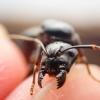- Formiculture.com
- Forums
- Gallery
- Members
- Member Map
- Chat

Tiny ant with white gaster in Palm Springs, CA
Started By
Manitobant
, Dec 31 2018 3:34 PM
5 replies to this topic
#1
 Offline
-
Posted December 31 2018 - 3:34 PM
Offline
-
Posted December 31 2018 - 3:34 PM
Caught on dec 31, 2018
Very tiny, about 2mm
Black with a white gaster
Found in funnel shaped nests that I mistakenly thought were founding chambers
http://www.formicult...0181231-143603/
Very tiny, about 2mm
Black with a white gaster
Found in funnel shaped nests that I mistakenly thought were founding chambers
http://www.formicult...0181231-143603/
My journals:
Polyergus Mexicanus: https://www.formicul...gs/#entry175528
Lasius minutus: https://www.formicul...cs/#entry174811
Lasius latipes: https://www.formicul...gs/#entry206449
General acanthomyops journal: https://www.formicul...yops-with-eggs/
Polyergus Mexicanus: https://www.formicul...gs/#entry175528
Lasius minutus: https://www.formicul...cs/#entry174811
Lasius latipes: https://www.formicul...gs/#entry206449
General acanthomyops journal: https://www.formicul...yops-with-eggs/
#2
 Offline
-
Posted December 31 2018 - 3:48 PM
Offline
-
Posted December 31 2018 - 3:48 PM
Maybe Temnothorax?
My Main Journal | My Neivamyrmex Journal | My Ant Adoption | My YouTube
Join the TennesseeAnts Discord Server! https://discord.gg/JbKwPgs
#3
 Offline
-
Posted December 31 2018 - 9:36 PM
Offline
-
Posted December 31 2018 - 9:36 PM
Brachymyrmex sp?
Plants r cool
#4
 Offline
-
Posted January 2 2019 - 7:52 AM
Offline
-
Posted January 2 2019 - 7:52 AM
From your description it sounds like Tapinoma melanocephalum as they are the only ants, that I know of, with white gasters. It also makes sense that they would be in Palm Springs because of it's popularity with tourists from around the world. To check my identification, just google the species listed above, and you will know.
- Guy_Fieri likes this
Hi there! I went on a 6 month or so hiatus, in part due, and in part cause of the death of my colonies.
However, I went back to the Sierras, and restarted my collection, which is now as follows:
Aphaenogaster uinta, Camponotus vicinus, Camponotus modoc, Formica cf. aserva, Formica cf. micropthalma, Formica cf. manni, Formica subpolita, Formica cf. subaenescens, Lasius americanus, Manica invidia, Pogonomyrmex salinus, Pogonomyrmex sp. 1, Solenopsis validiuscula, & Solenopsis sp. 3 (new Sierra variant).
#5
 Offline
-
Posted January 2 2019 - 8:36 AM
Offline
-
Posted January 2 2019 - 8:36 AM
Judging from the picture, the "whiteness" of the gaster is due to it being swollen from food stored in it. However, it's sort of hard to determine color with the lighting, though it looks more like Myrmicinae instead of Dolichoderinae.
Website: https://sites.google...home?authuser=0
Instagram: https://www.instagra.../bay.area.ants/
Youtube Channel: https://www.youtube....5Mh2eBAviuO2uw?
#6
 Offline
-
Posted January 2 2019 - 4:33 PM
Offline
-
Posted January 2 2019 - 4:33 PM
So sorry, I did not see the picture, or the link to it, I was in a rush.
Edited by NickAnter, January 2 2019 - 4:34 PM.
Hi there! I went on a 6 month or so hiatus, in part due, and in part cause of the death of my colonies.
However, I went back to the Sierras, and restarted my collection, which is now as follows:
Aphaenogaster uinta, Camponotus vicinus, Camponotus modoc, Formica cf. aserva, Formica cf. micropthalma, Formica cf. manni, Formica subpolita, Formica cf. subaenescens, Lasius americanus, Manica invidia, Pogonomyrmex salinus, Pogonomyrmex sp. 1, Solenopsis validiuscula, & Solenopsis sp. 3 (new Sierra variant).
0 user(s) are reading this topic
0 members, 0 guests, 0 anonymous users
















